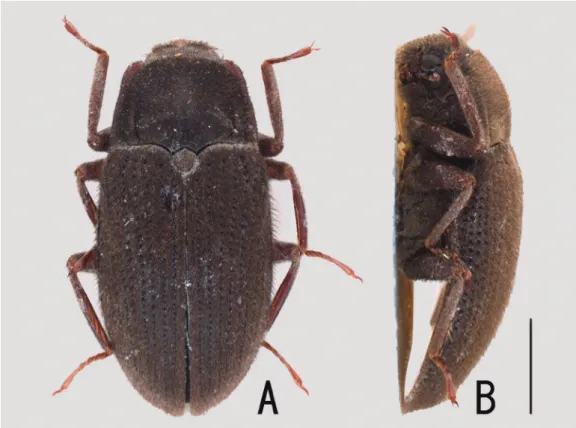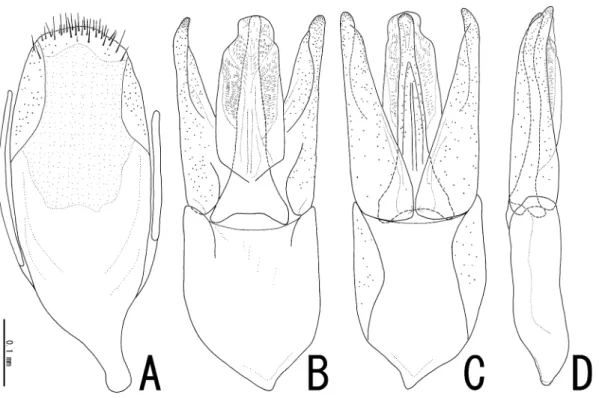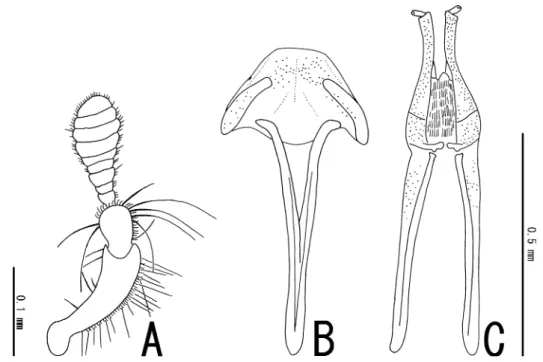A New Species of the Genus Dryopomorphus H
INTON(Coleoptera, Elmidae, Larainae) from Laos
Hiroyuki YOSHITOMI1) and Ming-Luen JENG2)
1) Entomological Laboratory, Faculty of Agriculture, Ehime University, Tarumi 3–5–7, Matsuyama, 790–8566 Japan
E-mail: hymushi@agr.ehime-u.ac.jp
2) Biology Department, National Museum of Natural Sciences, No. 1, Guanqian Rd., Taichung City 40453, Taiwan, R.O.C.
E-mail: jengml@mail.nmns.edu.tw
Abstract A new species of the genus Dryopomorphus, D. laosensis sp. nov., is described from Laos. This species is similar to the Japanese species D. extraneus HINTON, and differs from it in the short median lobe and parameres. The function of the cavities on sternite III is discussed. All the spe- cies of this genus are listed with Zoobank LSID in the appendix.
Introduction
The genus Dryopomorphus HINTON, 1936 is represented by 13 species from Japan, Malaysia, and Thailand (see appendix). No species of the genus has been recorded from the Indochina region.
In the present paper, we describe a new species of the genus from northern Laos. The function of the cavities on sternite III, which is thought to be a synapomorphy of the genus, is discussed based on SEM observation. In addition, all the species of this genus are listed with Zoobank LSID in the appen- dix.
Materials and Methods
General observation and dissection were made under a stereoscopic microscope (Leica MZ95). Microstructures were observed, under a microscope (Olympus BH-2), of the dissected part mounted on hollow slides with pure glycerine. After observation, the dissected parts were mounted on slides with Canada Balsam. Some structures were observed with an SEM (Hitachi S-225) after coating with gold.
Morphological abbreviations used in measurement are as follows: PL–length of pronotum; PW– width of pronotum; EL–length of elytra; EW–width of elytra; TL=PL+EL. The average is given in parentheses after the range.
The holotype and some paratypes designated in this paper will be preserved in the Ehime Uni- versity Museum, Matsuyama (EUMJ), and other paratypes in the Naturhistrisches Museum, Wien (NMW) and National Museum of Natural Science, Taiwan.
Technical terms of the genitalia follow KODADA and JÄCH (2005).
Hiroyuki YOSHITOMI and Ming-Luen JENG 46
Taxonomy
Dryopomorphus laosensis sp. nov.
(Figs. 1–4)
Type series. Holotype, male (EUMJ), Phou Pan, 1750 m Xam neua, Laos 16∼21–VI–2003 M. Sato leg. . Paratypes, 5 males & 1 female (EUMJ, NMW), same data as for the holotype; 5 males (EUMJ, NMW), WaterFall, 5 km W of BanSaleui 1350 m XamNaua, Laos 5–V–2002, M. Sato ; 1 female (EUMJ), 28 km W of Saleui XamNeua, Laos 23–VI–2003 M. Sato leg. ; 3 males (National Museum of Natural Science, Taiwan), Laos: Xamneua State a creek near Saleui & Ph. Pan, alt. 1453 m, 20°13′07.1″N 103°59′58.9″E 20∼23–V–2004. ML Jeng leg.
Description. M a l e (Fig. 1). Body elongate, slightly convex dorsally; dorsal surface densely covered with short adpressed yellowish setae and longer suberect black setae. Coloration of body blackish brown, but antennae, anterior corners of pronotum and legs reddish brown.
Head slightly convex dorsally. Eyes large, semicircular; the distance between eyes about 2.4 times as long as eye s diameter. Antennae (Fig. 3A) short; approximate ratio of each antennomeres (n=1) as 16.7 : 7.7 : 2.0 : 1.3 : 2.0 : 1.3 : 1.0 : 2.0 : 2.0 : 2.0 : 2.7. Maxillary palpi (Fig. 4A) cylindri- cal, truncate at apices. Labial palpi (Fig. 4B) short, shallowly concave in apical margin. Pronotum trapezoidal, straight in lateral margin; anterior corners projecting anteriorly, depressed dorsally; medi- an sulcus reaching about basal 1/2 of PL; sublateral sulci reaching about basal 1/3; disc gently convex
Fig. 1. Holotype of Dryopomorphus laosensis sp. nov. in dorsal (A) and lateral (B) views. Scale=1.0 mm.
dorsally; PW/PL 1.41–1.55 (1.46). Scutellum semicircular. Elytra oblong, subparallel-sided near base to apical 1/3; disc gently convex dorsally, with ten striae in each elytron; intervals flat; humeri feebly projecting; EL/EW 1.53–1.62 (1.56); EL/PL 2.55–3.00 (2.70); EW/PW 1.14–1.23 (1.18); TL/EW 2.11–2.18 (2.14).
Sternite IX (Fig. 2A) moderately sclerotized, oval, bearing short setae in apical part. Aedeagus (Fig. 2B–D) about 0.6 mm; phallobase slightly asymmetrical, wide, gently tapered basally, about 0.94 times as long as parameres; parameres symmetrical, evenly tapered posteriorly, rather pointed at api- ces; median lobe a little longer than parameres, slender, evenly tapered apically, rounded at apex; en- dophallus membranous, cylindrical, closely covered with minute furrows.
F e m a l e. Sexual dimorphism indistinct in external feature; PW/PL 1.42; EL/EW 1.51; EL/PL 2.58; EW/PW 1.21; TL/EW 2.10. Sternite VIII (Fig. 3B) well sclerotized, trapezoidal, with a long and stout median strut. Ovipositor (Fig. 3C) relatively short; stylus oblong, relatively small; apical parts of coxite long and slender; approximate ratio of stylus, coxite and valvifer (n=1) as 1.0 : 10.0 : 14.7.
Measurements. Male (n=9): TL 3.90–4.15 (4.02) mm; PW 1.55–1.68 (1.59) mm; PL 1.00–1.10 (1.09) mm; EL 2.80–3.05 (2.93) mm; EW 1.80–1.95 (1.87) mm. Female (n=1): TL 4.30 mm; PW 1.70 mm; PL 1.20 mm; EL 3.10 mm; EW 2.05 mm.
Remarks. Judging from the characteristics of male genitalia (symmetrical and slender param- eres) and the setae of the dorsal surface (densely covered with longer suberected setae), this species seems to be more related to Japanese species than to Malaysian and Thailand species. In particular, this species is similar to Dryopomorphus extraneus HINTON in body size and similar shape of body outline and male genitalia, but differs from it in the following characteristics: phallobase long, about
Fig. 2. Male genitalia of Dryopomorphus laosensis sp. nov. ― A, Sternite IX; B–D, aedeagus in ventral (B), dorsal (C), and lateral (D) views.
Hiroyuki YOSHITOMI and Ming-Luen JENG 48
0.9 times the length of parameres (short in extraneus, about 0.7 times the length of parameres); medi- an lobe short and slender with rounded apex (long and robust with pointed apex in extraneus); sternite IX oval (elongate in extraneus).
Discussion
The cavities on abdominal sternite III in both sexes are exclusively present in all Dryopomor- phus species, and were thought to be synapomorphic to the genus (SPANGLER, 1985). None of the oth- er members of Elmidae or even of Dascilloidea has been reported possessing such peculiar cavities (GREBENNIKOV & LESCHEN, 2010). The function of the structure, however, was not clearly understood. HINTON (1971) suspected they were the openings of some as yet confirmed defensive glands or phero- monal organs, whereas CROWSON (1981) inferred that the specialized cavities may function as mycan- gia, an adaptation for a symbiotic relationship with algae.
We observed the cavities on sternite III of Dryopomorphus extraneus HINTON and D. laosensis sp. nov. in detail by SEM. It appears that the cavities are not likely to be mycangia, as evidenced by the total absence of any fungal spores in the cavities. In addition, the openings of the cavities are cov- ered with long and irregularly arranged setae which hide the entrance (Fig. 4C, E) and thus obstruct any spores getting in and out of the cavities.
The occurrence of mycangia has been documented in many beetle lineages, but most of the cas- es, except those in Curculionidae and Attelabidae, were not supported by solid evidence but only on inference based on the fungus-feeding habits (GREBENNIKOV & LESCHEN, 2010). Exoskeletal pits with uncertain function, termed pseudomycangia by these authors, were rarely reported in water beetles, with two exceptions of hydraenid Nucleotops in South Africa and elmid Dryopomorphus in East and
Fig. 3. Male antenna (A) and female genitalia (B, C) of Dryopomorphus laosensis sp. nov. ― B, Sternite VIII; C, ovipositor.
Southeast Asia. The latter mainly dwell in submerged accumulations of plant debris or mud with roots along the stream bank, or on submerged wood in shaded forest streams (YOSHITOMI & SATÔ, 2005; ČIAMPOR et al., 2012). Whether they are mycophagous, xylophagous or algophagous is not clear. Ac-
Fig. 4. Dryopomorphus laosensis sp. nov. ― A, Apex of maxillary palpus; B, labial palpus; C, abdominal ven- trites, arrow indicates the cavity on sternite III; D, inner surface of sternite III; E, opening of cavity on sternite III; F, interior part of cavity on sternite III.
Hiroyuki YOSHITOMI and Ming-Luen JENG 50
cordingly, it is premature to conclude Dryopomorphus is a fungus-feeder and then further infer the pits on their abdominal ventrites are mycangia. Though our study primarily ruled out the mycangial function of the cavities, the true function remains unanswered and requires future investigation.
Acknowledgements
We thank the late Dr. Masataka SATÔ for his support in sample collection, Dr. Fedor ČIAMPOR Jr. (Slovak Academy of Sciences) and Dr. Masahiro SAKAI (EUMJ) for their suggestions on taxonomy and mycangia, and Mr. Dennis MURPHY (The United Graduate School of Agricultural Sciences, Ehime University) for his critical reading of our draft.
This study is supported in part by KAKENHI (24405028; principal investigator: S. OKAJIMA).
要 約
吉富博之・M.-L. JENG:ラオス産ハバビロドロムシ属(コウチュウ目ヒメドロムシ科)の 1 新種.― ア
ジアから 13 種が知られていたハバビロドロムシ属 Dryopomorphus HINTONの 1 新種をラオスから記載した.
また,本属が有する第 3 腹節の特有な凹みについて観察し,その機能について考察した.
References
CROWSON, R. A., 1981. The biology of the Coleoptera. 802 pp. Academic Press, London.
ČIAMPOR Jr., F., Z. ČIAMPOROVÁ-ZAŤOVIČOVÁ & J. KODADA, 2012. Malaysian species of Dryopomorphus HINTON, 1936 (Insec- ta: Coleoptera: Elmidae). Zootaxa, 3564: 1–16.
GREBENNIKOV, V. V., & R. A. B. LESCHEN, 2010. External exoskeletal cavities in Coleoptera and their possible mycangial func- tions. Ent. Sci., 13: 81–98.
HINTON, H. E., 1971. The species of Dryopomorphus (Coleoptera, Elmidae). Entomologist, 104: 293–297, pl. 5.
KODADA, J., & M. A. JÄCH, 2005. Elmidae. pp. 471–496. In BEUTEL, R. G., & R. A. B. LESCHEN (eds.), Handbook of Zoology, Vol. IV (Part 38), Coleoptera, Beetles, Vol. 1: Morphology and Systematics Archostemata, Adephaga, Myxophaga, Po- lyphaga partim). XI+567 pp. Berlin–New York: Walter de Gruyter.
SPANGLER, P. J., 1985. A new species of the aquatic beetle genus Dryopomorphus from Borneo (Coleoptera: Elmidae: Larinae). Proc. biol. Soc. Wash., 98: 416–421.
YOSHITOMI, H., & M. SATÔ, 2005. A revision of the genus Dryopomorphus (Coleoptera, Elmidae) of Japan. Elytra, Tokyo, 33: 455–473.
Appendix: Species List of the Genus Dryopomorphus with ZooBank LSID Dryopomorphus HINTON, 1936
urn:lsid:zoobank.org:act:DA3C08C4-E8D2-4405-B36E-EB9678521A10 Dryopomorphus amami YOSHITOMI et M. SATÔ, 2005
urn:lsid:zoobank.org:act:9E49928B-E646-478F-98DE-A6577EB4BEA7 Dryopomorphus bishopi HINTON, 1971
urn:lsid:zoobank.org:act:29997022-C27B-4065-B2F0-AE116AB32708 Dryopomorphus extraneus HINTON, 1936
urn:lsid:zoobank.org:act:C139EB91-9E2B-439E-BB1E-B2456FBEA204 Dryopomorphus grandis ČIAMPOR, ČIAMPOROVÁ-ZAŤOVIČOVÁ et KODADA, 2012
urn:lsid:zoobank.org:act:10E85D6F-3FA2-475A-BC7C-4D001230A1E9
Dryopomorphus hendrichi ČIAMPOR et KODADA, 2006
urn:lsid:zoobank.org:act:84BF1422-F97C-4772-B7E9-06130B64C7AD Dryopomorphus jaechi ČIAMPOR, ČIAMPOROVÁ-ZAŤOVIČOVÁ et KODADA, 2012
urn:lsid:zoobank.org:act:A55CF4BA-38E3-45A7-A3E5-80190914CFD6 Dryopomorphus laosensis sp. nov.
urn:lsid:zoobank.org:act:D11B3540-8845-429C-BA66-22D8AA86F413 Dryopomorphus memei ČIAMPOR, ČIAMPOROVÁ-ZAŤOVIČOVÁ et KODADA, 2012
urn:lsid:zoobank.org:act:420BA3D7-46CC-4ADF-BD97-551F75535A58 Dryopomorphus nakanei NOMURA, 1958
urn:lsid:zoobank.org:act:6F6BB4BE-E538-45C9-8070-6C072F374C4E Dryopomorphus pekariki ČIAMPOR, ČIAMPOROVÁ-ZAŤOVIČOVÁ et KODADA, 2012
urn:lsid:zoobank.org:act:62177612-1434-4EED-9DFF-1F9BA31779E6
Dryopomorphus sarawacensis ČIAMPOR, ČIAMPOROVÁ-ZAŤOVIČOVÁ et KODADA, 2012 urn:lsid:zoobank.org:act:58DF38DF-997B-4F76-BFB0-9672A61ABC34
Dryopomorphus satoi SPANGLER, 1985
urn:lsid:zoobank.org:act:67BD8722-1325-45FC-8F62-B76586CF3543 Dryopomorphus siamensis KODADA, 1993
urn:lsid:zoobank.org:act:BC213C1C-3F1E-4984-9E9C-25413EE8CA01 Dryopomorphus yaku YOSHITOMI et M. SATÔ, 2005
urn:lsid:zoobank.org:act:1818B24D-05A3-424C-A8DA-E079FDD29E74
Manuscript received 21 March 2013; revised and accepted 28 July 2013.


